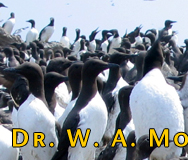

| Funks |
| Great Auk |
| Gannets |
| Common Murre |
| people |
| research |
| international polar year |
| publications |
| public outreach |
| contact |
Funk Island Ecological Reserve

Seabird research in the Funk Island
Ecological Reserve was begun in the 1950s by Les Tuck (see Tuck 1961), the last Dominion and first Canadian Wildlife service official in Newfoundland and Labrador and later J.L. Paton Chair at Memorial University of Newfoundland (Montevecchi 1981). Since 1977, that research has been carried out continuously by MUN scientists and students working with fishers from Valleyfield to Carmanville (Montevecchi and Tuck 1987).
Research has focused on seabirds as responders and indicators to changes in fish and ocean conditions on the northeast coast. A major cold water perturbation in 1991 led to radical shifts in seabird diets that were associated with broader scale shifts in marine food webs and oceanography throughout the 1990s (Montevecchi and Myers 1997; Montevecchi et al. 2006). The gannets' catches of mackerel, squid and salmon are highly associated with fisheries catches over multiple spatial and temporal scales (and river returns of salmon; Montevecchi and Myers 1995; Montevecchi and Cairns 2003). The murres' landing of capelin showed decreases in size and percent gravid through the 1990s and consequently reductions in chick body condition (Davoren and Montevecchi 2003).
In 2005, the gannets exhibited a major shift in their prey landing and for the first time in 16 years (since 1989) landed more warm-water fish (mackerel) than cold-water fish (capelin). This corresponded with massive fishery landings of mackerel throughout the Newfoundland region. Could this be indicative of shift back to system with high abundances of mackerel, squid, saury and pothead whales, earlier spawning of capelin, etc.? We will be studying the persistence of these changes and reporting our findings nationally, internationally and back to local communities.
Explore the Funk Island Ecological Reserve
Publications
Pictures
Links